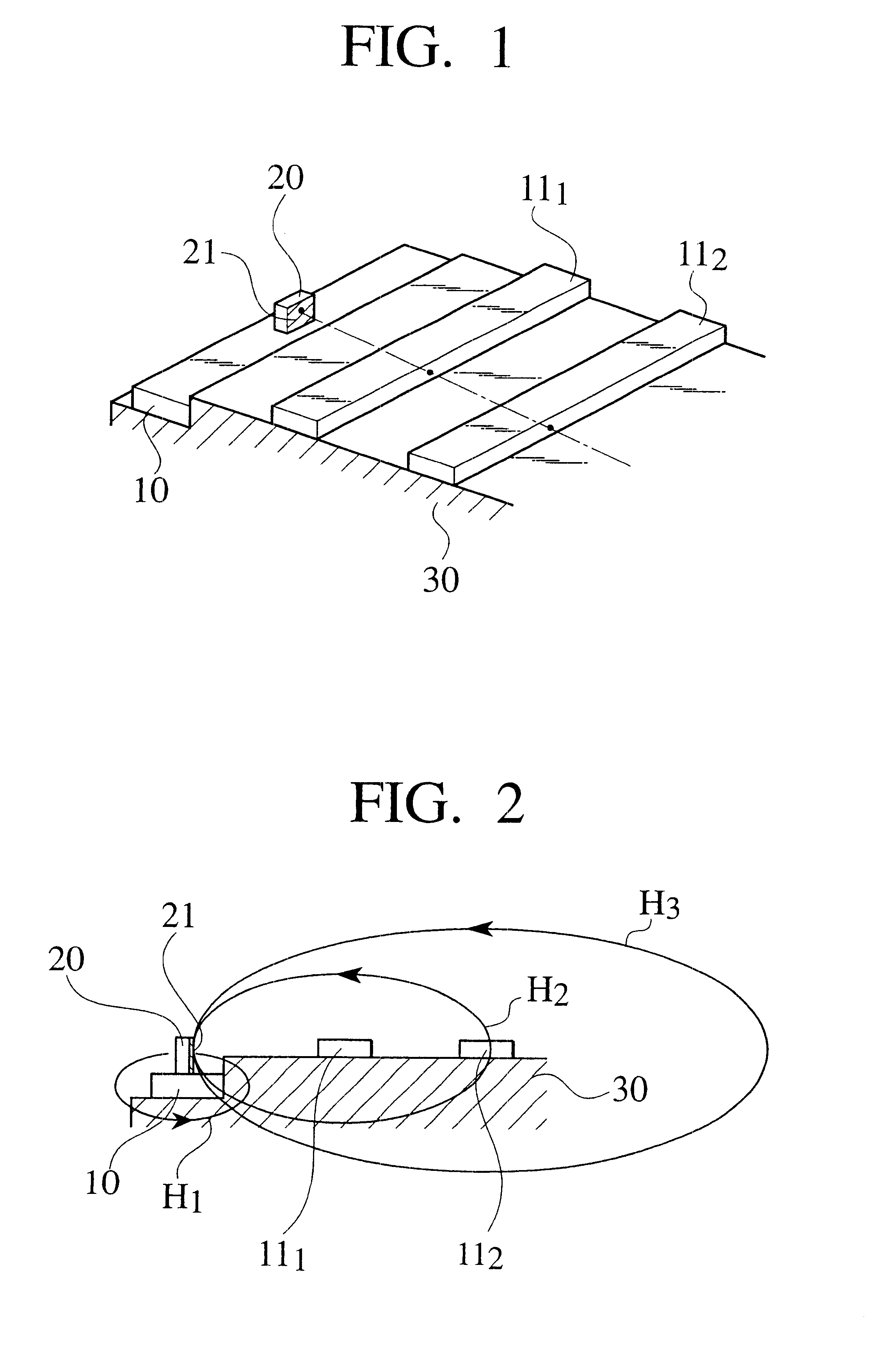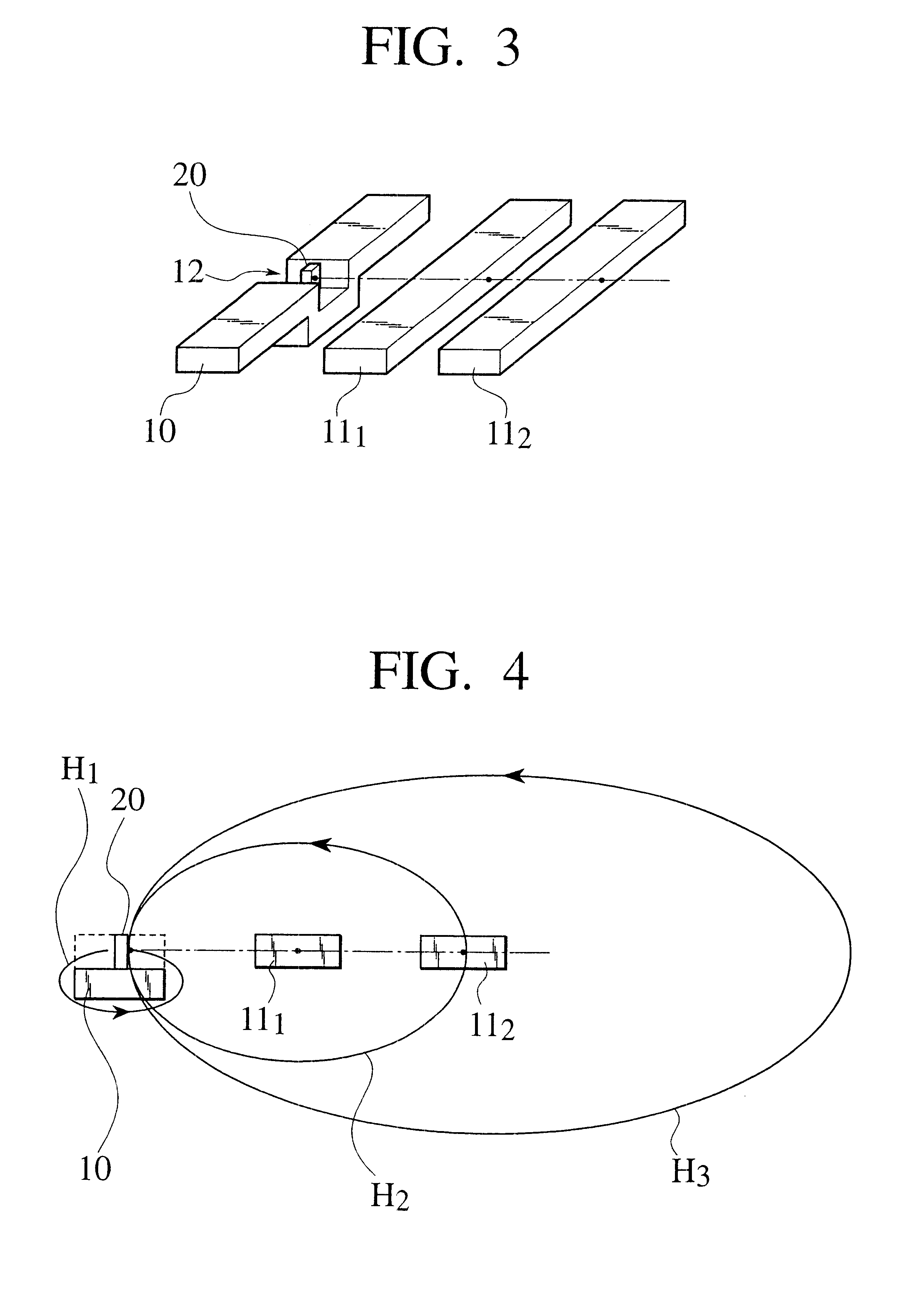Current detector
a current detector and detector technology, applied in the direction of instruments, magnetic measurements, measurement using dc-ac conversion, etc., can solve the problems of increased cost of current detector, inability to enhance current detection precision, and inability to precisely detect current flowing through the to-be-measured conductor
- Summary
- Abstract
- Description
- Claims
- Application Information
AI Technical Summary
Benefits of technology
Problems solved by technology
Method used
Image
Examples
first embodiment
(First Embodiment)
FIG. 1 is a perspective view showing a structure of a current detector according to a first embodiment of the present invention. This current detector comprises a conductor to be measured (which will be referred to as "to-be measured conductor, hereinafter) 10, a first conductor 11.sub.1, a second conductor 11.sub.2, a Hall element 20 and a substrate 30. These elements are usually accommodated in an electric connection box (not shown). In the first embodiment, a magnetic-force collecting core is not used.
The to-be measured conductor 10 is a linear conductor through which a to-be measured current flows, and the Hall element 20 is secured on the to-be measured conductor 10. The Hall element 20 corresponds to a magnetic-electric power converting element of the present invention. The Hall element 20 generates a voltage (Hall voltage) signal corresponding to a magnetic flux density entering a magnetic-force sensing face (magnetic flux detecting face) of the Hall element...
second embodiment
(Second Embodiment)
FIG. 3 is a perspective view showing a structure of a current detector according to a second embodiment of the invention. This current detector comprises a conductor to be measured 10, a first conductor 11.sub.1, a second conductor 11.sub.2, a Hall element 20 and a substrate 30. These elements are usually accommodated in an electric connection box (not shown). In the second embodiment, a magnetic-force collecting core is not used.
The to-be measured conductor 10 is a conductor through which a to-be measured current flows. The to-be measured conductor 10 is formed with a bent portion 12 formed by bending a portion of the to-be measured conductor 10 into a U-shape. The Hall element 20 is secured to the bent portion 12. The Hall element 20 corresponds to a magnetic-electric power converting element of the present invention, and is the same as that used in the first embodiment.
The first conductor 11.sub.1 and the second conductor 11.sub.2 are linear conductors through ...
third embodiment
(Third Embodiment)
A current detector of the third embodiment is different from those of the first and second embodiments in that a plurality of to-be conductors are provided.
FIG. 6 is a perspective view showing a structure of the current detectors according to a third embodiment of the invention, FIG. 7 is a plan view of the conductors, and FIG. 8 is a side view of the conductors. This current detector comprises a first to-be measured conductor 10.sub.1, a second to-be measured conductor 10.sub.2, a third to-be measured conductor 10.sub.3, a first Hall element 20.sub.1, a second Hall element 20.sub.2 and a third Hall element 20.sub.3. These elements are usually accommodated in an electric connection box (not shown). In the third embodiment, a magnetic-force collecting core is not used.
The first to third to-be measured conductors 10.sub.1 to 10.sub.3 are conductors through which to-be measured currents flow, and have the same structures as that of the to-be measured conductor 10 of t...
PUM
 Login to View More
Login to View More Abstract
Description
Claims
Application Information
 Login to View More
Login to View More - R&D
- Intellectual Property
- Life Sciences
- Materials
- Tech Scout
- Unparalleled Data Quality
- Higher Quality Content
- 60% Fewer Hallucinations
Browse by: Latest US Patents, China's latest patents, Technical Efficacy Thesaurus, Application Domain, Technology Topic, Popular Technical Reports.
© 2025 PatSnap. All rights reserved.Legal|Privacy policy|Modern Slavery Act Transparency Statement|Sitemap|About US| Contact US: help@patsnap.com



